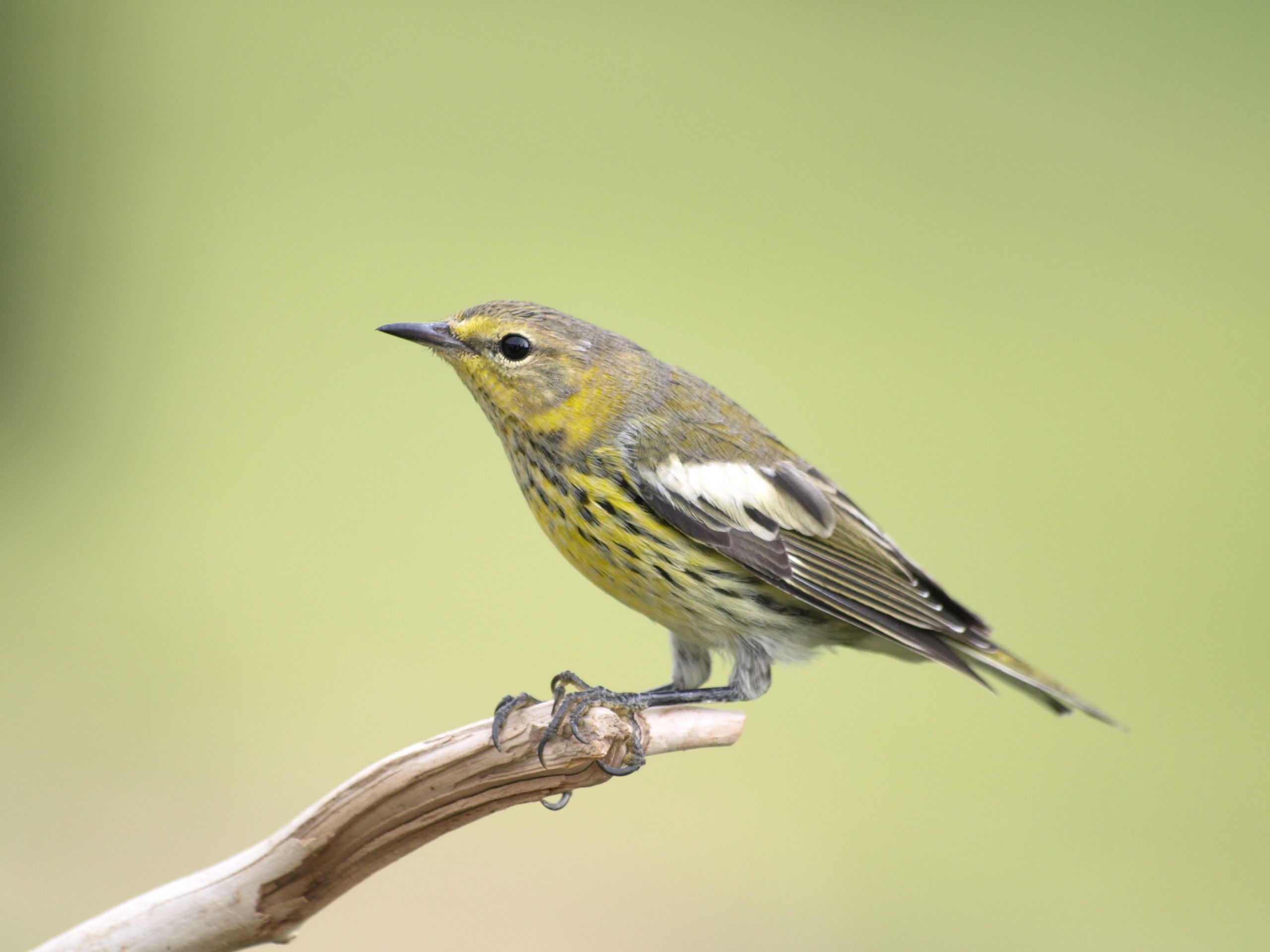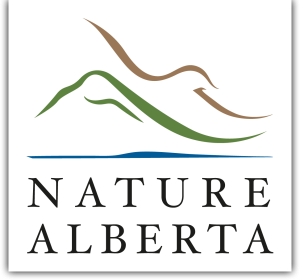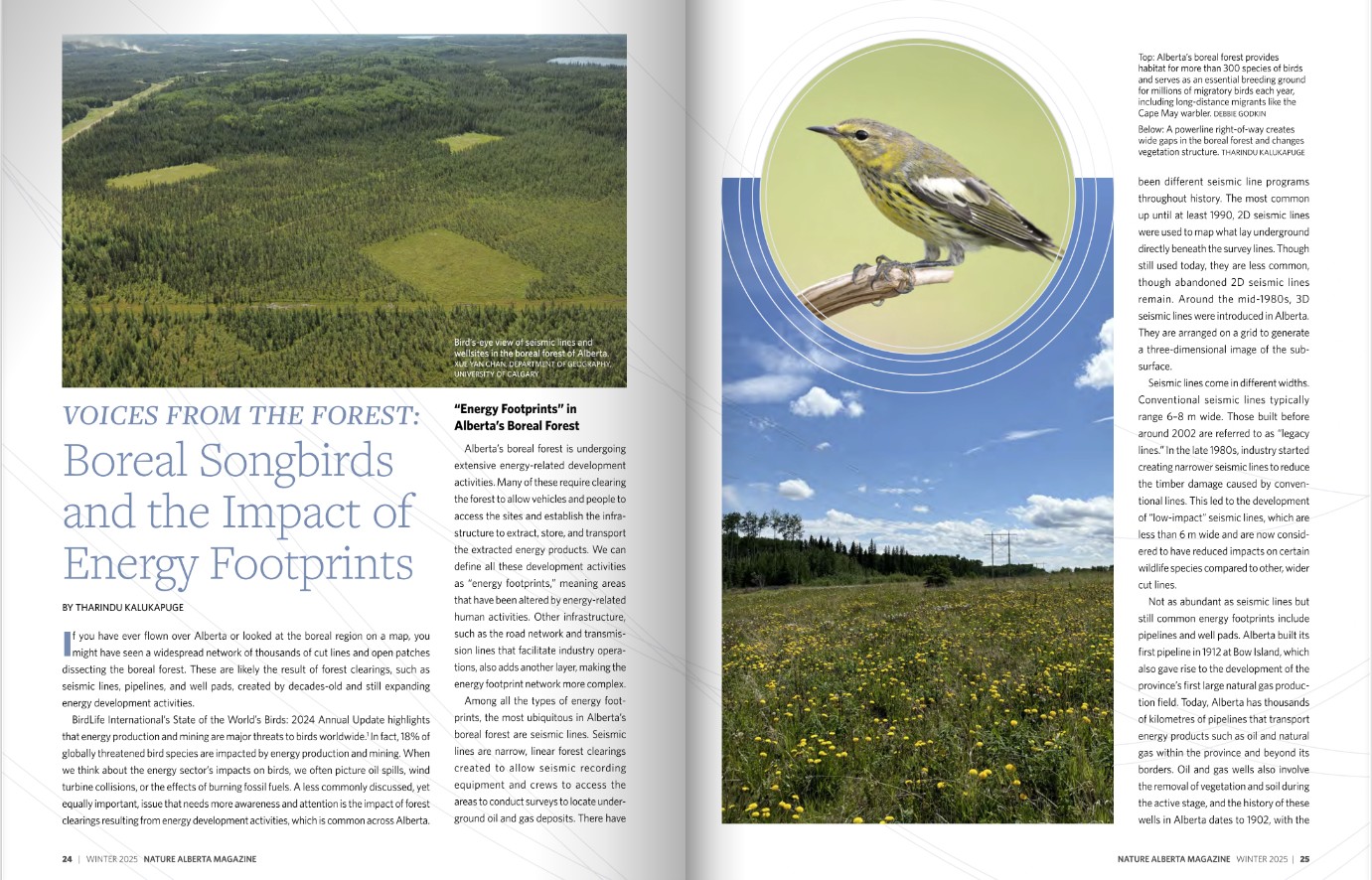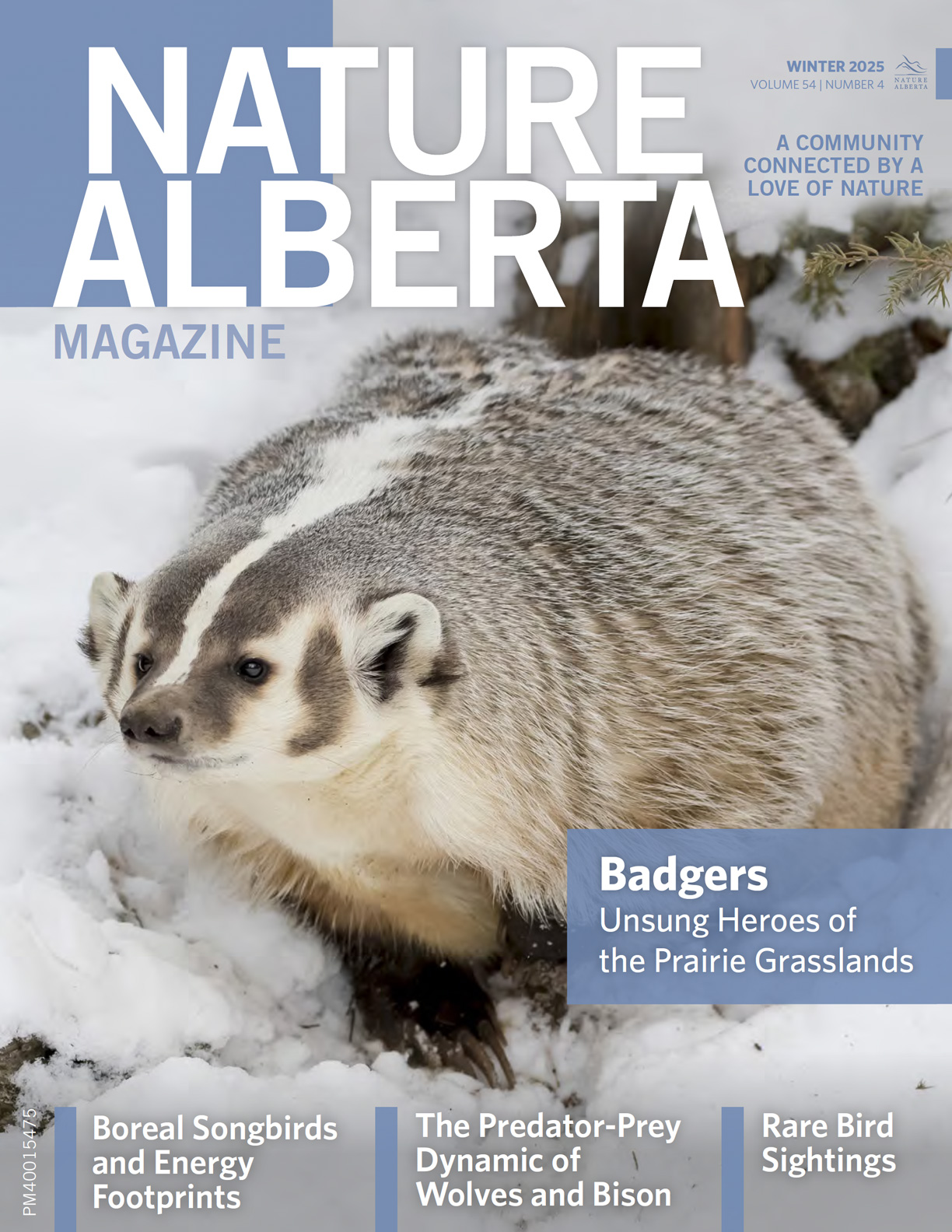Voices from the Forest: Boreal Songbirds and the Impact of Energy Footprints
11 February 2025

By Tharindu Kalukapuge
If you have ever flown over Alberta or looked at the boreal region on a map, you might have seen a widespread network of thousands of cut lines and open patches dissecting the boreal forest. These are likely the result of forest clearings, such as seismic lines, pipelines, and well pads, created by decades-old and still expanding energy development activities.
BirdLife International’s State of the World’s Birds: 2024 Annual Update highlights that energy production and mining are major threats to birds worldwide.1 In fact, 18% of globally threatened bird species are impacted by energy production and mining. When we think about the energy sector’s impacts on birds, we often picture oil spills, wind turbine collisions, or the effects of burning fossil fuels. A less commonly discussed, yet equally important, issue that needs more awareness and attention is the impact of forest clearings resulting from energy development activities, which is common across Alberta.
“Energy Footprints” in Alberta’s Boreal Forest
Alberta’s boreal forest is undergoing extensive energy-related development activities. Many of these require clearing the forest to allow vehicles and people to access the sites and establish the infrastructure to extract, store, and transport the extracted energy products. We can define all these development activities as “energy footprints,” meaning areas that have been altered by energy-related human activities. Other infrastructure, such as the road network and transmission lines that facilitate industry operations, also adds another layer, making the energy footprint network more complex.
Among all the types of energy footprints, the most ubiquitous in Alberta’s boreal forest are seismic lines. Seismic lines are narrow, linear forest clearings created to allow seismic recording equipment and crews to access the areas to conduct surveys to locate underground oil and gas deposits. There have been different seismic line programs throughout history. The most common up until at least 1990, 2D seismic lines were used to map what lay underground directly beneath the survey lines. Though still used today, they are less common, though abandoned 2D seismic lines remain. Around the mid-1980s, 3D seismic lines were introduced in Alberta. They are arranged on a grid to generate a three-dimensional image of the subsurface.
Seismic lines come in different widths. Conventional seismic lines typically range 6–8 m wide. Those built before around 2002 are referred to as “legacy lines.” In the late 1980s, industry started creating narrower seismic lines to reduce the timber damage caused by conventional lines. This led to the development of “low-impact” seismic lines, which are less than 6 m wide and are now considered to have reduced impacts on certain wildlife species compared to other, wider cut lines.
Not as abundant as seismic lines but still common energy footprints include pipelines and well pads. Alberta built its first pipeline in 1912 at Bow Island, which also gave rise to the development of the province’s first large natural gas production field. Today, Alberta has thousands of kilometres of pipelines that transport energy products such as oil and natural gas within the province and beyond its borders. Oil and gas wells also involve the removal of vegetation and soil during the active stage, and the history of these wells in Alberta dates to 1902, with the first oil well in western Canada located in what is now Waterton Lakes National Park. Once a wellsite is abandoned, it leaves a square-shaped patch in the forest, perforating the landscape until the area is fully restored to its original state.
Millions of Birds Overlap With the Energy Industry
The oil and gas industry in Alberta creates a concerning situation because a significant portion of these activities take place in one of the most unique ecosystems on the planet: the boreal forest. Alberta’s boreal forest is a massive northern ecosystem that covers 58% of the province’s land and is a large part of Canada’s boreal forest, which spans approximately 270 million hectares and accounts for 28% of the world’s largest terrestrial biome. The boreal region, particularly in Alberta, is heavily impacted by human activities. These human footprints occupy around 20% of the boreal forest; energy activities alone affect approximately 7,000 km² of the boreal landscape in Alberta.
Alberta’s boreal forest is an ecologically sensitive region, home to 48 Important Bird Areas (IBAs), such as the Peace-Athabasca Delta and Hay-Zama Lakes. These areas are also protected under the Ramsar Convention, which designates wetlands of international importance (ramsar.org). Alberta’s boreal forest provides essential breeding ground for millions of migratory songbirds each year. Among them are long-distance migrants like the Cape May warbler, which winters in the Caribbean or the southern United States and migrates thousands of kilometres to breed in the boreal forests, or the white-throated sparrow, known for its “Oh sweet Canada Canada Canada” song, which winters as far south as Florida, returning each year to the boreal forest during the breeding season.
The Impacts of Energy Footprints on Birds
Even though the energy industry in Alberta has been around for decades, its impacts on boreal wildlife, especially birds, have not been explicitly studied in some aspects. Specifically, how birds perceive these forest clearings; whether all footprints cause the same disturbance effects and, if not, how much they vary and what drives these variations; and how we can restore these landscapes with a wildlife perspective rather than a human one.
Over the past four years of my PhD research, I have hiked along thousands of linear features, including seismic lines, pipelines, and transmission lines, and visited hundreds of wellsites in the northern and northeastern boreal forests of Alberta. In the field, I use autonomous recording units (ARUs) to monitor the response of songbirds to energy footprints. ARU technology is becoming a popular choice for wildlife research in North America because it collects wildlife vocalizations, as well as other sounds in the environment, in a non-invasive manner. ARUs provide valuable information about not only species presence and abundance, but also changes in vocal behaviour in response to human activities, habitat use and avoidance, and even body condition data that previously could only be collected through direct observations or mist netting. In my research, ARUs help us understand how songbirds respond to different energy footprint types and how their community structure changes as vegetation recovers in these disturbed areas.
Why Focus on Birds?
Birds have long been used as indicators of environmental changes caused by human activities. A notable example comes from Rachel Carson’s groundbreaking 1962 book Silent Spring, in which she described that birds were among the first to respond to the harmful effects of DDT. Birds, being highly mobile, can give us a lot of information about habitat quality by either moving away from or returning to their original habitats. Over the years, our understanding of how birds respond to human activities around the world has grown immensely. This accumulated knowledge allows us to ask new questions and learn even more about these responses.
Birds, particularly songbirds, are highly vocal compared to other organisms in the environment. Their vocalizations bring valuable information, such as how many are present; their behavioral responses, like courtship and territoriality; and even details about human activities happening in their surroundings. A good example comes from my colleague Natalie Sánchez, who found that Lincoln’s sparrows in the boreal forest adapt their vocalization in response to the noise from compressor stations. While they keep the same song type, they increase how often they sing, likely to make sure that songs reach their mates despite the background noise.2
From a public engagement perspective, people like birds. We find them charismatic, admire their beautiful plumage and songs, and are fascinated by their behaviour. This connection helps the findings generated through scientific research reach the public more effectively.
Signs of Hope for Boreal Forest Recovery
In the discussion of oil and gas development in Alberta, the answers birds provide to the question of whether we can restore these landscapes are fascinating. Here are two examples from the research of my colleagues. Jocelyn Gregoire found that Canada warblers are more likely to be found near regenerating seismic lines in the boreal forest when these lines have more woody vegetation cover.3 Similarly, Hedwig Lankau showed that ovenbirds avoid seismic lines with little to no vegetation but will use those with vegetation recovery.4 These species’ responses give us hope that some energy footprints can be recovered, either by allowing natural regeneration or through effective active restoration practices.
What Does Our Recent Study Tell Us About Energy Sector Linear Features?
In our recent article published in the journal Avian Conservation and Ecology, we presented our findings on how songbird communities respond to energy sector linear disturbances, such as seismic lines, pipelines, and transmission lines.5 These linear features vary from 4- to 6-m-wide seismic lines to 100-m transmission lines. To the human eye, the impacts of a 6-m seismic line are different from those of a much wider pipeline or transmission line, and their impacts can range from habitat dissection, to fragmentation, to habitat loss as the cutline gets wider. However, how boreal songbirds respond to specific widths of these linear features was not fully understood.
To address this question, we monitored songbirds in thousands of different linear features using ARUs in various forest types in the northern and northeastern boreal forest of Alberta over the past four years. Our findings from the study, which focused on deciduous-dominant forests, show that mature forest species and forest specialists decline in areas with wider linear features like pipelines and power lines. Interestingly, we observed higher species richness associated with wider pipelines and transmission lines compared to narrow seismic lines. This is likely due to the changes in vegetation caused by wider linear features, which seem to attract more shrub and early-seral birds into the linear feature area.
This study provided new insights into the management and restoration of linear features in the boreal forest, showing that the width of linear features generates specific impacts that influence changes in songbird communities. We recommend that impact assessments and provincial bird models used for regulatory decision-making focus on the effects generated by specific widths rather than grouping all energy sector linear features into broader categories that may overlook the specific impacts associated with each width.

Setting up an autonomous recording unit (ARU) in the boreal forest of northeastern Alberta to monitor songbirds. EMMA GLINNY
What’s Next?
We now know that songbirds likely respond to the width of linear features because of the associated changes in vegetation. Our next aim is to understand what a recovered energy footprint is from birds’ perspectives, and how birds settle back into recovering areas as vegetation regrows. This will help us identify the level of vegetation recovery needed in energy sector footprints and inform stakeholders on the actions required to facilitate recovery, ultimately converting these footprints so they no longer act as a human footprint for boreal birds.
References:
- BirdLife International. State of the World’s Birds: 2024 Annual Update. https://datazone.birdlife.org/2024-annual-update
- Sánchez, N.V., E.M. Bayne and B. Hilje (2023). Lincoln's sparrow (Melospiza lincolnii) increases singing rate in areas with chronic industrial noise. Ibis, 165(3):944-958. https://doi.org/10.1111/ibi.13174
- Gregoire, J.M., R.W. Hedley and E.M. Bayne (2022). Canada Warbler response to vegetation structure on regenerating seismic lines. Avian Conservation and Ecology, 17(2):26. https://doi.org/10.5751/ACE-02262-170226
- Lankau, H.E., E.M. Bayne and C.S. Machtans (2013). Ovenbird (Seiurus aurocapilla) territory placement near seismic lines is influenced by forest regeneration and conspecific density. Avian Conservation and Ecology, 8(1):5. https://doi.org/10.5751/ACE-00596-080105
- Kalukapuge, T., L.F.V. Leston, J.A. Martínez-Lanfranco, and E. Bayne (2024). Response of boreal songbird communities to the width of linear features created by the energy sector in Alberta, Canada. Avian Conservation and Ecology, 19(2):14. https://doi.org/10.5751/ACE-02730-190214
Tharindu Kalukapuge is a researcher/PhD student in the Bayne Lab in the University of Alberta Department of Biological Sciences, in collaboration with the Boreal Ecosystem Recovery Assessment project.
Read the Original Article for this Post
For a richer reading experience, view this article in the professionally designed online magazine with all images and graphs in place.
This article originally ran in the Winter 2025 issue of Nature Alberta Magazine (Vol. 54 | No. 4).


